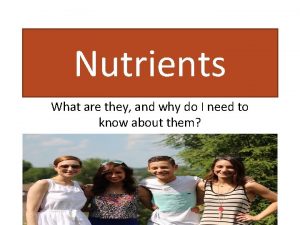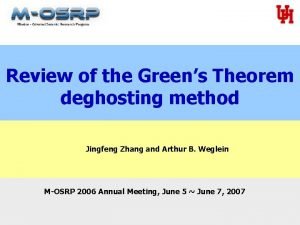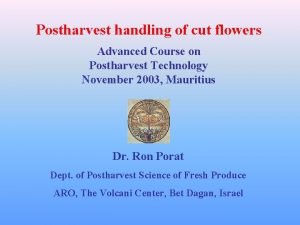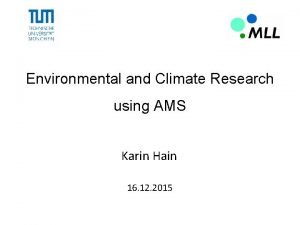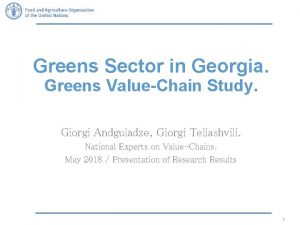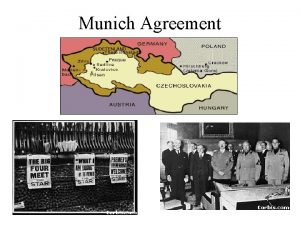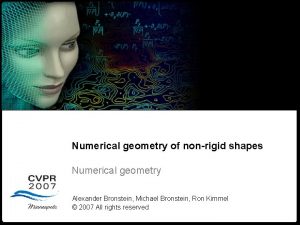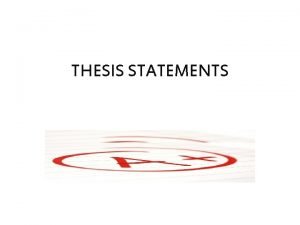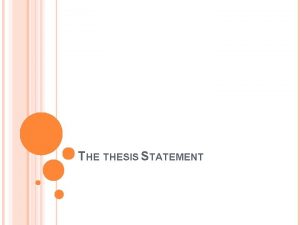THESIS Munich 13 06 2006 Using Numerical Greens






























- Slides: 30

THESIS, Munich, 13. 06. 2006 Using Numerical Green’s Function Method to Investigate Ground Motion Variation Haijiang Wang LMU In collaboration with Heiner Igel, LMU, Alain Cochard, LMU, Michael Ewald, LMU.

Outline • Motivation (source related ground motion uncertainty) • Numerical Green‘s Function approach • Uncertainty – due to hypocentre location • Uncertainty – due to varying slip distribution • Conclusions

Motivation Basin effect Amplitude amplification Duration time elongation Ewald et al. , 2006 But few attention was paid on source complexity (3 D). . .

Motivation For large earthquake, point source is not sufficient and at least kinematic finite source is necessary to describe the source process • Special attention should be paid to the directivity • Source complexity • Static displacement (asperity) • Rupture velocity • Slip velocity

Numerical Green‘s Function • Theory • Optimal largest subfault size • Study area and fault • Database created

Numerical Green‘s Function Theory

Numerical Green‘s Function Optimal subfault size – homogeneous case Spatial discretization (km) 1000 Temporal discretization (s) 0. 0822 S-wave velocity (km/s) 3. 9 Simulation time (s) 50 Study area (km) 150× 130 x 60 PML Nodes 10 Constant slip rate (m/s) 1 Accuracy increases with the increase of • cut-off frequency • rupture velocity • magnitude

Numerical Green‘s Function Study area N SCEC cvm version 3

Numerical Green‘s Function Grant and Shearer, 2004 Newport Inglewood Fault • • • M 6. 4 Long Beach earthquake in 1933 (Hauksson and Gross, 1991) Probable source for a damaging earthquake Near-vertical plane and predominant right-lateral slip (SCEC cfm) SCEC cfm

Numerical Green‘s Function Verification – heterogeneous case subfault size 1. 5 km can be applied as the principal subfault size to the generation of the NGF data base Spatial discretization 300 m Temporal discretization 0. 018 s Lowest S-wave velocity 1. 4 km/s Simulation time 65 Number of cells 550× 500 x 150 PML Nodes 10 Magnitude 7. 0 Fault dimension 16 x 36 km

Numerical Green‘s Function Database Spatial discretization (km) 0. 300 Temporal discretization (s) 0. 01811 Lowest S-wave velocity (km/s) 1. 400 Simulation time (s) 65 Number of cells 550× 500 x 150 Fault length dimension (km) 60× 19 Surface grid distance (m) 600 Ground motion components 6 Total database size (Tb) 1. 5

Summary 1 • Equation for synthesization of NGFs is developed. • Optimal subfault size is investigated both for homogeneous media and heterogeneous media. • Database is created for the Newport Inglewood fault embedded in the Los Angeles basin with appropriate setup.

Uncertainty - Hypocentre Outline • • Motivation Hypocentre locations Velocity snapshots Basin amplification • PGV characteristics variation with hypocentre location

Uncertainty - Hypocentre Static displacement and hypocentres Guatteri et al. , 2005

Uncertainty - Hypocentre Velocity snapshots

Uncertainty - Hypocentre Velocity Profiles

Uncertantity - Hypocentre PGV characteristics

Uncertantity - Hypocentre Varying source depth

Summary 2 • Horizontal hypocentre variation influences the ground motion • Vertical hypocentre variation has only slight influence on the ground motion • In the area far from the fault, the medium plays main role on ground motion variation while in the area very close to the fault plane the hypocentre does

Uncertainty - Slip Outline • Quasi-dynamic rutpure process generation • Directivity effect • Slip variation effect • PGV characteristics

Uncertantity - Slip Guatteri et al. , 2005 Quasi-dynamic rutpure process

Uncertantity - Slip Wang et al. , 2006, submitted to ESG

Uncertantity - Slip Directivity Somerville et al. , 1997 Aki & Richards, 2002

Uncertantity - Slip Different directivity on different components the fault perpendicular component is dominated by the directivity effect and the fault parallel and vertical components have significant contribution from the 3 -D structure (basin effects) and slip distribution. Wang et al. , 2006, submitted to ESG

Uncertantity - Slip Three individual slips Wang et al. , 2006, submitted to ESG

Uncertantity - Slip PGV characteristics: maximum value and standard deviation Wang et al. , 2006, submitted to ESG

Summary 3 • Directivity effect dominates the fault perpendicular component • Fault parallel and vertical components have significant contribution from the 3 -D structure (basin effects) and slip distribution. • Slip asperity elevates the ground motion in its nearby area. • The maximum seismic motion variation on the surface is dominated by directivity.

Conclusions We investigate the ground motion variations due to sets of parameters using our new-developed method Numerical Green’s Function… 1. Horizontal hypocentre location variations influence the ground motion. 2. Dominant directivity effect on the fault perpendicular component is confirmed by our simulations while fault parallel components are controled by both the source properties and the basin structure, for this specific case. 3. Slip asperity elevates the ground motion in its nearby area. 4. The maximum seismic motion variation on the surface is dominated by directivity.

Future Works • Investigation of rotational motions – Peak rotational motions – Attenuation relations for rotations – Source vs. 3 D effects for rotations

End Thanks
 Emulsification
Emulsification Vitamins foods examples
Vitamins foods examples Doc greens menu
Doc greens menu Green's theorem is a particular case of stokes theorem
Green's theorem is a particular case of stokes theorem Greens theorem
Greens theorem Emerald ash borer nj
Emerald ash borer nj Dry greens
Dry greens Post harvest handling of cut flowers and greens
Post harvest handling of cut flowers and greens Forever fields of greens benefits
Forever fields of greens benefits Bermuda grass golf greens
Bermuda grass golf greens Which is the example of grouped data
Which is the example of grouped data Munich currency
Munich currency Lmu munich law
Lmu munich law Munich re natcatservice
Munich re natcatservice Munich agreement
Munich agreement Why did beer hall putsch fail
Why did beer hall putsch fail The courtyard of the old residency in munich
The courtyard of the old residency in munich Mll munich
Mll munich Autoportrait (dürer, munich)
Autoportrait (dürer, munich) The courtyard of the old residency in munich
The courtyard of the old residency in munich Peter mortimer munich
Peter mortimer munich Munich airport car parking
Munich airport car parking Bayern munich igraci
Bayern munich igraci Hotels oktoberfest munich
Hotels oktoberfest munich Munich weather radar
Munich weather radar Munich putsch sources
Munich putsch sources Molching germany
Molching germany Why was the munich conference unsuccessful
Why was the munich conference unsuccessful Sat to munich
Sat to munich Open thesis vs closed thesis examples
Open thesis vs closed thesis examples Using system.collections
Using system.collections

